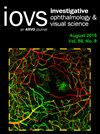Ocular Accommodative and Pupillary Responses During Fixation on Augmented Reality With a Maxwellian Display.
IF 5
2区 医学
Q1 OPHTHALMOLOGY
引用次数: 0
Abstract
Purpose This study aimed to investigate the changes in ocular refraction and pupillary diameter during fixation on augmented reality (AR) images using a Maxwellian display. Methods Twenty-two healthy young volunteers (average age, 20.7 ± 0.5 years) wore a Maxwellian display device in front of their right eye and fixated on an asterisk displayed on both a liquid-crystal display (real target) and a Maxwellian display (AR target) for 29 seconds (real as a baseline for 3 seconds, AR for 13 seconds, and real for 13 seconds) at distances of 5.0, 0.5, 0.33, and 0.2 meters. A binocular open-view autorefractometer was used to measure the ocular refraction and pupillary diameter of the left eye. Results Accommodative (5.0 meters, 0.28 ± 0.29 diopter [D]; 0.5 meter, -0.12 ± 0.35 D; 0.33 meter, -0.43 ± 0.57 D; 0.2 meter, -1.20 ± 0.82 D) and pupillary (5.0 meters, 0.07 ± 0.22 mm; 0.5 meter, -0.08 ± 0.17 mm; 0.33 meter, -0.16 ± 0.20 mm; 0.2 meter, -0.25 ± 0.24 mm) responses were negative when the real target distances were farther away. The accommodative response was significantly and positively correlated with the pupillary response during fixation on the AR target (R2 = 0.187, P < 0.001). Conclusions Fixating on AR images using a Maxwellian display induces accommodative and pupillary responses. Accommodative responses depend on the distance between real objects. Overall, the Maxwellian display does not completely eliminate accommodation in real space.通过 Maxwellian 显示器观察增强现实时的眼球屈光和瞳孔反应。
目的 本研究旨在调查在使用麦克斯韦式显示屏固定在增强现实(AR)图像上时眼球屈光度和瞳孔直径的变化。5岁)在右眼前方佩戴一个麦克斯韦显示设备,并在5.0米、0.5米、0.33米和0.2米的距离内,对液晶显示屏(真实目标)和麦克斯韦显示屏(AR目标)上显示的星号进行29秒钟的定焦(真实目标作为基线3秒钟,AR目标13秒钟,真实目标13秒钟)。使用双目开视自动屈光度计测量左眼的屈光度和瞳孔直径。结果屈光度(5.0 米,0.28 ± 0.29 屈光度[D];0.5 米,-0.12 ± 0.35 D;0.33 米,-0.43 ± 0.当实际目标距离较远时,瞳孔(5.0 米,0.07 ± 0.22 毫米;0.5 米,-0.08 ± 0.17 毫米;0.33 米,-0.16 ± 0.20 毫米;0.2 米,-0.25 ± 0.24 毫米)和瞳孔(5.0 米,0.07 ± 0.22 毫米;0.5 米,-0.08 ± 0.17 毫米;0.33 米,-0.16 ± 0.20 毫米;0.2 米,-0.25 ± 0.24 毫米)反应为负。固定在 AR 目标物上时,适应反应与瞳孔反应呈显著正相关(R2 = 0.187,P < 0.001)。屈光反应取决于真实物体之间的距离。总体而言,麦克斯韦式显示屏并不能完全消除真实空间中的适应反应。
本文章由计算机程序翻译,如有差异,请以英文原文为准。
求助全文
约1分钟内获得全文
求助全文
来源期刊
CiteScore
6.90
自引率
4.50%
发文量
339
审稿时长
1 months
期刊介绍:
Investigative Ophthalmology & Visual Science (IOVS), published as ready online, is a peer-reviewed academic journal of the Association for Research in Vision and Ophthalmology (ARVO). IOVS features original research, mostly pertaining to clinical and laboratory ophthalmology and vision research in general.

 求助内容:
求助内容: 应助结果提醒方式:
应助结果提醒方式:


